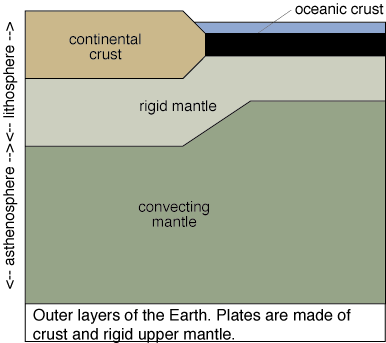
Selected topics which were covered in one of the prerequisite courses are given below and you are encouraged to review these materials during the first few weeks of the course. The image above is from the Exercise To Try reference given below.
If it has been a while since you thought about topics in physical geology you might want to begin with Plate Tectonics
Note the position of the boundary between the asthenosphere and the lithosphere. This is a boundary based on behavior. The lithosphere is a rigid unit whereas the underlying asthenosphere is plastic. Crust and mantle are terms that refer to the composition of the units and not their behavior.
Throughout the semester I will refer you to this set of WWW resources developed for a course in Engineering Geology taught in the Department of Geological Sciences at the University of Saskatchewan, Canada.
Santiago Chile is located at 30 degrees S latitude and 70 degrees W longitude. What is the velocity of the South American Plate at this point? The Juan Fernandez island on the Nazca Plate is located at 30 degrees S latitude and 80 degrees W longitude. What is its velocity? The South American Plate and the Nazca Plate are converging. Will the South American Plate "overtake" the Nazca and "sit" on top of the East Pacific Rise? Try the Plate Motion Calculator and use the third model - HS2
Geology 202, as taught at the University of British Columbia, is an introduction to petrology which I will reference throughout our course. The section on The Rock Cycle and Plate Tectonics is quite good. In particular review their discussion of the Rock Cycle.